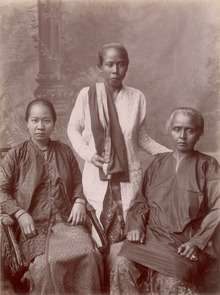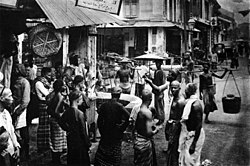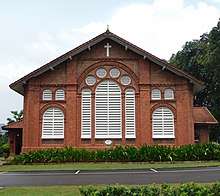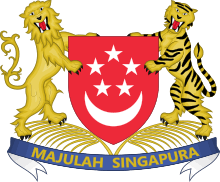Singaporeans
Singaporeans or Singaporean people refers to citizens or people who identify with the city-state of Singapore.[3] Singapore is a multi-ethnic, multi-cultural and multi-lingual country, and Singaporeans of Chinese, Malay, Indian and Eurasian descent have made up the vast majority of the population since the 19th century. Singaporean culture and law does not equate nationality with race or ethnicity, but with citizenship and permanent allegiance.[4]
 | |
 | |
| Total population | |
| c. 3.8 million | |
| Regions with significant populations | |
| Diaspora total | c. 340,751[2][lower-alpha 2] |
| 91,002[2] | |
| 64,739[2] | |
| 58,432[2] | |
| 39,018[2] | |
| 23,524[2] | |
| 12,799[2] | |
| 12,582[2] | |
| 9,709[2] | |
| 5,734[2] | |
| 4,155[2] | |
| 4,126[2] | |
| 2,735[2] | |
| 2,638[2] | |
| 2,512[2] | |
| 2,349[2] | |
| 1,830[2] | |
| Languages | |
| |
| Religion | |
Buddhism · Islam · Hinduism · Christianity
| |
In 1819, the port of Singapore was established by Sir Stamford Raffles, who opened it to free trade and free immigration on the island's south coast. Many immigrants from the region settled in Singapore. By 1827, the population of the island was composed of people from various ethnic groups.[5]
Singapore is a multilingual and multicultural society home to people of groups of many different ethnic, religious, and national origins, with the majority of the population made up of Chinese, Malay, Indian and Eurasian descent. The Singaporean identity was fostered as a way for the different ethnic groups to integrate and identify with the nation, while preserving the culture and traditions of each ethnic group, instead of assimilating the minority cultures into a single majority culture.[6]
According to a 2017 survey by the Institute of Policy Studies, 49% of Singaporeans identifies with both the Singaporean identity and their ethnic identity equally, while 35% would identify as "Singaporeans" first and 14.2% would identify with their ethnic identity.[7] As of 2019, the population of Singaporeans stands at 4,026,200 and the population of overseas Singaporeans stands at 340,751, with 217,200 individuals retaining their citizenship.[1][2]
Overview
Indigenous population
The earliest records of settlement on the island date back to the 2nd century, where the island was identified as a trading port which was part of a chain of similar trading centres that linked Southeast Asia with the Tamil Indians and the Mediterranean.[8] The earliest settlers of the island were known as the Orang Lauts, and the island was an outpost of the Srivijaya Empire until it was invaded by the Tamil Emperor Rajendra Chola I of the Chola Empire in the 11th century.[9] According to the 19th century Chinese record Investigation of Southern Pacific (南洋蠡測) (Nanyang Li Ce), it described the presence of Chinese tombs in Singapore. Words and inscriptions recording the period of Later Liang and Emperor Gong of Song were found on these tombs and this may suggest that from 907 to 1274, some Chinese had settled, lived, died and were buried in Singapore.[10][11]
A small Malay kingdom, known as the Kingdom of Singapura, was founded in 1299 by a fleeing Srivijayan prince, Sang Nila Utama, who was crowned as the Raja of the new state. After the fall of the kingdom in 1398, the island fell under the suzerainty of various regional empires and Malayan sultanates until its destruction by Portuguese raiders in 1613.[5]
Prior to the arrival of Raffles, there were hundreds of indigenous Malays living on the island under the Johor Sultanate. Most of the indigenous Malays came from the Malay Archipelago.[12] There were an estimated 150 people living on the island, who were predominantly Orang Laut with small population of 120 Malays who were the followers of Temenggong Abdul Rahman, and about 20–30 Chinese.[13]
Modern Singapore
The majority of Singaporeans today are descendants of immigrants who settled on the island when Singapore was founded as a British trading port by Raffles in 1819, except for the Malays who are indigenous to the region of Malaya.[14] At that time, Raffles decided Singapore would be a free port and as news of the free port spread across the archipelago, Bugis, Javanese, Peranakan Chinese, South Asian and Hadhrami Arab traders flocked to the island, due to the Dutch trading restrictions.[15] After six months of Singapore's founding as a free port, the population increased to 5,000, with the first census of 1824 showing that 6,505 out of the 10,683 total were Malays and Bugis settlers.[16] Within the first few months of becoming a British settlement, a large number of Chinese migrants also started to settle on the island. In 1825, the population of the island had passed the ten thousand mark and by the census of 1826, there were more Chinese with a population of 6,088, as compared to 4,790 Malays excluding the Bugis and Javanese.[4]
By 1871, due to the influx of migrants from Malaya, China, India and other parts of Asia, Singapore's population had reached nearly 100,000, with over half of them being Chinese.[17] Many of these early migrants were predominantly male and they would usually return to their home countries after they had earned enough money. By the early to mid twentieth century, an increasingly significant number of migrant workers chose to stay permanently, with their descendants forming the bulk of Singapore's population today.[13][18]
In 1957, Singapore attained self-governance and Singaporean citizenship was granted to selected residents who were born in Singapore or the Federation of Malaya, British citizens who had been resident for two years, and others who had been resident for ten years.[19] On September 16, 1963, all Singaporeans effectively became Malaysian citizens as Malaya, Singapore, North Borneo and Sarawak were merged to form Malaysia.[20] However, about two years after the merger, Singapore seceded from Malaysia on August 9, 1965 and Malaysian citizenship was withdrawn from Singaporean citizens. Singaporean nationality law was incorporated into the new Constitution of Singapore. The constitution repealed the 1957 Ordinance, and all persons who were citizens as of 16 September 1963 by virtue of the Ordinance continued to be Singaporean citizens.
Today, Singaporean citizenship is granted by birth, by descent, or by registration. Although provided for in the Constitution, citizenship by naturalisation is no longer granted. The government instead uses the constitutional provision for citizenship by registration to grant citizenship to resident aliens.[21]
Racial and ethnic groups
Singaporeans with Chinese ancestry make up 74.3%, Malays make up 13.4%, Indians make up 9%, and residents of other descent make up 3.2% of the 3,965,800 of the resident population (including persons holding Permanent Residency).[22] To avoid physical racial segregation and formation of ethnic enclaves common in other multi-racial societies, the Singapore government implemented the "Ethnic Integration Policy" (EIP) in 1989 where each block of units are sold to families from ethnicities roughly comparable to the national average.[23]
Today, the Chinese-Malay-Indian-Others (CMIO) model is the dominant organising framework of race in Singapore.[24] The country also celebrates Racial Harmony Day to commemorate the 1964 race riots in Singapore and to remember the consequences of racial disharmony the country experienced during the 1964 racial riots[25], which were a series of riots that resulted in a total of 36 deaths and 560 others suffered severe injuries.[26]
Singaporeans of other ethnicities notably the Arab, Armenians, Chitty, Eurasians, Malaysians and Sri Lankans are classified into broader ethnic groups under the CMIO model. The Javanese are classified under the Malay ethnic group[27] and the Peranakans are classified under the Chinese ethnic group are two examples of the classification of race and ethnicity in Singapore.[28][29] Other foreign communities in the country or Singaporeans of other ethnic origins includes the Australians, Filipinos, Japanese, Koreans, Nepalis, Pakistanis, and Italians.
Culture

Singaporean culture is a mix of Asian and European cultures, with influences from the Malay, Indian, Chinese, and Eurasian cultures. This is reflected in the architectural styles of buildings in several distinct ethnic neighbourhoods, such as Little India, Chinatown and Kampong Glam and Singlish, which is a local creole language which consists of words originating from English, Malay, Hokkien, Teochew, Cantonese and Tamil, used by Singaporeans in a less formal setting. Due to Singapore's diverse ethnic makeup, the Singapore Constitution prohibits discrimination based on race, religion, descent and place of birth. The state thus promotes cultural policies based on multiculturalism and multiracialism, instead of cultural assimilation.[30][31]
About 70% of Singaporeans also identify with other ethnic cultures in Singapore, notably the Chinese, Malay and Indian cultures.[7] Major festivals including Chinese New Year, Hari Raya Puasa, Deepavali, Vesak Day, Christmas, Good Friday and New Year's Day which are celebrated by the different major racial and religious groups are designated as public holidays.
Religion
Singapore is the world's most religiously diverse nation,[32] with Singaporeans following various religious beliefs and practices due to the country's diverse ethnic and cultural mix. The Inter-Religious Organisation, Singapore (IRO) recognises 10 major religions being practiced in the city state.[33] Dharmic religions have the highest number of adherents in Singapore, with 33% of the population practising Buddhism and 5% of the population practising Hinduism. Many Singaporeans are also adherents of Abrahamic religions, with 18.7% of the population identifying as Christian, and 14% identifying as Muslim.
Other prominent faiths practised by Singaporeans include Taoism (10%), Chinese folk religion, and other Dharmic religions like Sikhism and Jainism. A small percentage of Singapore's population practices Zoroastrianism and Judaism. 18.5% not identifying with any religion and 0.9% of Singaporeans identify as atheist. In addition, practice of hybrid religions is also common such as the incorporation of Taoism and Hindu traditions into Buddhism and vice versa.
| Religious group |
Population % 2010[34][35] |
Population % 2015[36] |
|---|---|---|
| Buddhism | 33.3% | 33.2% |
| Taoism and folk religion | 10.9% | 10.0% |
| Christianity | 18.4% | 18.7% |
| Catholicism | 7.1% | 6.7% |
| Protestantism and other non-Catholic | 11.3% | 12.0% |
| Not religious | 17.0% | 18.5% |
| Islam | 14.7% | 14.0% |
| Hinduism | 5.1% | 5.0% |
| Other religions | 0.7% | 0.6% |
Language
Singapore's historical roots as a trading settlement gave rise to an influx of foreign traders,[37] and their languages were slowly embedded in Singapore's modern day linguistic repertoire. With the influx of traders into Singapore, Bazaar Malay (Melayu Pasar), a creole of Malay and Chinese, emerged as the lingua franca of the island, which was the language of trade in the Malay Archipelago.[38][39] However, under the British colonial government, English gained prestige as the language of administration, law and business in Singapore, and eventually displaced Bazar Malay as the bridging language among the population.[37] As government administration increased, infrastructure and commerce developed, and access to education further catalysed the spread of English among Singaporeans.
Today, Singapore has four official languages, English, Malay, Mandarin, and Tamil.[40] Malay is the ceremonial national language of the country and is the home language to 13% of the population.[41] Although the younger generation of non-Malay people are non-proficient in the Malay language, Malay is used in the national anthem of Singapore and also in citations for Singapore orders and decorations and military foot drill commands.[42] Almost all Singaporeans are bilingual since Singapore's bilingual language education policy[43], with Singapore English as the de facto lingua franca spoken by Singaporeans today.[44] It is officially the main language of instruction in all school subjects except for Mother Tongue lessons and is also the common language of administration, law and business.[45] In 2009, more than 20 languages were identified as being spoken in Singapore, reflecting a rich linguistic diversity in the city.[46][47]
References
- "2019 Singapore Population in Brief" (PDF). Strategy Group Singapore, Prime Minister's Office. Retrieved 27 June 2020.
- "International migrant stock 2019". United Nations. Retrieved 25 June 2020.
This figure includes people who are of Malaysian origin in Singapore, not only Malaysian citizens
- Josey, Alex (15 February 2013). Lee Kuan Yew: The Crucial Years. Marshall Cavendish International Asia Pte Ltd. p. 457. ISBN 9789814435499.
By legal definition the Singaporean is a citizen of Singapore; By emotive definition, a Singaporean is a person by birth, upbringing or residence in Singapore
- Saw Swee-Hock (March 1969). "Population Trends in Singapore, 1819–1967". Journal of Southeast Asian History. 10 (1): 36–49. JSTOR 20067730.
- "History of Singapore". One World Nations Online. Retrieved 29 August 2015.
- "Arts, culture and a distinct Singaporean identity". The Straits Times. 22 May 2017. Retrieved 23 June 2020.
Singaporean variants of Chinese, Malay, Indian and Eurasian cultures, and a growing Singaporean identity that we all share, suffusing and linking up our distinct individual identities and ethnic cultures.
- Matthews, M.; Lim, L.; SHANTHINI, S.; Cheung, N. (1 November 2017). "CNA-IPS SURVEY ON ETHNIC IDENTITY IN SINGAPORE" (PDF). Institute of Policy Studies, Lee Kuan Yew School of Public Policy. IPS Working Papers. 28: 16–17. Retrieved 23 June 2020.
- Hack, Karl. "Records of Ancient Links between India and Singapore". National Institute of Education, Singapore. Archived from the original on 26 April 2006. Retrieved 4 August 2006.
- Heidhues 2001, p. 27
- "《南洋蠡测》 / 颜斯综著" (PDF). NUS.
- 饒宗頤. 新加坡古事記. Chinese University Press. p. viii. ISBN 9789622014497.
- Vasil, R K (2000). Governing Singapore: democracy and national development. Allen & Unwin. p. 96. ISBN 978-1-86508-211-0.
- Saw Swee-Hock (30 June 2012). The Population of Singapore (3rd ed.). ISEAS Publishing. pp. 7–8. ISBN 978-9814380980.
- Jenny Ng (7 February 1997). "1819 - The February Documents". Ministry of Defence (Singapore). Retrieved 1 March 2015.
- "Singapore – Founding and Early Years". U.S. Library of Congress. Retrieved 18 July 2006.
- "First Census of Singapore is Taken". History SG.
- Brenda S.A. Yeoh (2003). Contesting Space in Colonial Singapore: Power Relations and the Urban Built Environment. NUS Press. p. 317. ISBN 978-9971692681.
- "Founding of Modern Singapore". Ministry of Information, Communications and the Arts. Archived from the original on 8 May 2009. Retrieved 13 April 2011.
- Lepoer, Barbara Leitch (ed.) (1989). Singapore : A Country Study. Washington, D.C.: GPO for the Library of Congress.CS1 maint: extra text: authors list (link), ch. 10 ("Road to Independence").
- HistorySG. "Signing of the Malaysia Agreement - Singapore History". eresources.nlb.gov.sg. National Library Board. Retrieved 9 March 2020.
- "Citizenship rules of Singapore". Government of Singapore. Retrieved 20 February 2015.
- "Population trend" (PDF). Singstat. Department of Statistics Singapore. Archived from the original (PDF) on 7 November 2017. Retrieved 5 November 2017.
- HDB InfoWEB: Ethnic Integration Policy & SPR Quota : Selling Your Flat Archived 22 February 2015 at the Wayback Machine. Retrieved 1 March 2015
- Tan, Eugene (2004). ""We, the Citizens of Singapore …": Multiethnicity, its Evolution and its Aberrations.". In Lai, Ah Eng (ed.). Beyond Rituals and Riots: Ethnic Pluralism and Social Cohesion in Singapore. Institute of Policy Studies and Eastern Universities Press. pp. 65–97.
- "Speech by Mr Heng Swee Keat, Minister for Education, at the Racial Harmony Day Celebrations on Monday, 21 July 2014, at 9:20am at Elias Park Primary School". MOE, Singapore. Archived from the original on 19 March 2015. Retrieved 1 March 2015.
- Cheng, Adeline Low Hwee (2001). "The past in the present: Memories of the 1964 'racial riots' in Singapore". Asian Journal of Social Science. 29 (3): 431–455. doi:10.1163/156853101X00181.
- LePoer, Barbara Leitch (1991). Singapore, a country study. Federal Research Division, Library of Congress. p. 83. Retrieved 17 February 2013.
Singapore Malay community leaders estimated that some 50 to 60 percent of the community traced their origins to Java and an additional 15 to 20 percent to Bawean Island, in the Java Sea north of the city of Surabaya.
- "Debate over CMIO model as diversity grows". Today. 8 August 2017. Retrieved 26 June 2020.
- "Commentary: I am Peranakan not Chinese". Channel News Asia. 7 October 2018. Retrieved 26 June 2020.
- Thio, Li-ann (October 2019). "Irreducible Plurality, Indivisible Unity: Singapore Relational Constitutionalism and Cultivating Harmony Through Constructing a Constitutional Civil Religion". German Law Journal. Cambridge University Press. 20: 1007–1034. doi:10.1017/glj.2019.75.
- "PM Lee Hsien Loong at the Official Opening of the Singapore Chinese Cultural Centre". Prime Minister's Office (Singapore). 19 May 2017. Retrieved 23 June 2020.
Our aim is integration, not assimilation. No race or culture in Singapore is coerced into conforming with other cultures or identities, let alone that of the majority.
- "Global Religious Diversity". Pew Research. Retrieved 15 April 2014.
- "Introducing Singapore's IRO – Inter-Religious Organisation". Retrieved 14 September 2019.
- "Demographic Characteristics, Education, Language and Religion" (PDF), Singapore Census 2010, Statistical Release 1, p. 11, archived from the original (PDF) on 16 May 2017, retrieved 1 April 2015
- "Census of Population 2010 Statistical Release 1" (PDF). Department of Statistics. Archived from the original (PDF) on 13 November 2013. Retrieved 2 February 2014.
- Statistics Singapore: 2015 General Household Survey Archived 5 May 2017 at the Wayback Machine. Religion data Archived 9 April 2016 at the Wayback Machine
- Lee, C.L. (2013). "Saving Chinese-language education in Singapore". Current Issues in Language Planning. 13 (4): 285–304. doi:10.1080/14664208.2012.754327.
- Bao, Z.; Aye, K.K. (2010). "Bazaar Malay topics". Journal of Pidgin and Creole Languages. 25 (1): 155–171. doi:10.1075/jpcl.25.1.06bao.
- Platt, John; Weber, Heidi (1980). English in Singapore and Malaysia: Status, features, functions. Oxford: Oxford University Press.
- "Official languages and national language". Constitution of the Republic of Singapore. Archived from the original on 27 September 2007. Retrieved 11 November 2010.
- Tan, P.K.W. (2014). Singapore's balancing act, from the perspective of the linguistic landscape. Journal of Social Issues in Southeast Asia, 29(2), 438-436.
- Singapore Arms and Flag and National Anthem Act (Cap. 296, 1985 Rev. Ed.)
- See Language education in Singapore
- Gupta, A.F. Fischer, K. (ed.). "Epistemic modalities and the discourse particles of Singapore" (DOC). Approaches to Discourse Particles. Amsterdam: Elsevier: 244–263.
- "31 March 2000". Moe.gov.sg. Archived from the original on 6 March 2012. Retrieved 27 January 2011.
- David, Maya Esther (2008). "Language Policies Impact on Language Maintenance and Teaching Focus on Malaysia Singapore and The Philippines" (PDF). University of Malaya Angel David Malaysia. Archived from the original on 5 July 2012. Retrieved 9 September 2017.
- Lewis, M. Paul (2009). "Languages of Singapore". Ethnologue: Languages of the World. Archived from the original on 5 July 2012. Retrieved 13 November 2010.
Notes
- This number excludes permanent residents of Singapore, while the statistics in the article includes the permanent residents.[1]
- This number includes Singaporean citizens and people of Singaporean descent who renounced their citizenship, statistics of overseas Singaporeans retaining their citizenship stands at 217,200.[1]
Bibliography
- Heidhues, Mary Somers (2001), Southeast Asia: A Concise History, Hudson and Thames, ISBN 978-0-500-28303-5
- Koh, Jamie (2009), Culture and Customs of Singapore and Malaysia, ABC-CLIO, ISBN 9780313351167
- Wright, Arnold (2012), Twentieth Century Impressions of British Malaya: Its History, People, Commerce, Industries, and Resources, Repressed Publishing LLC, (originally first published in 1908), ISBN 9781462298440

.jpg)

